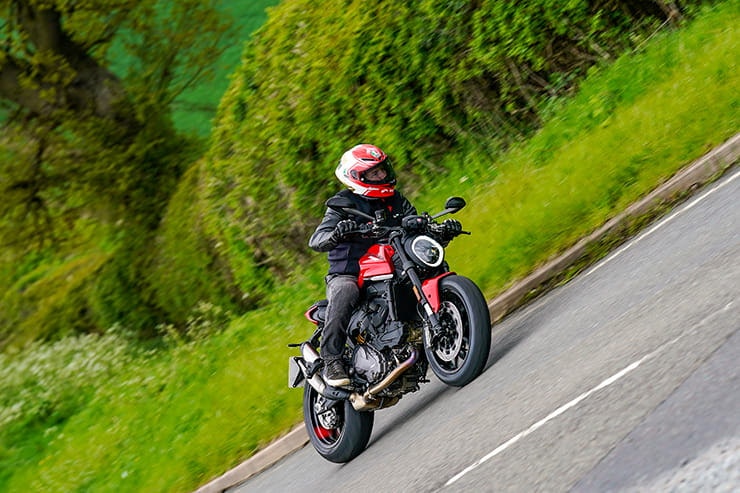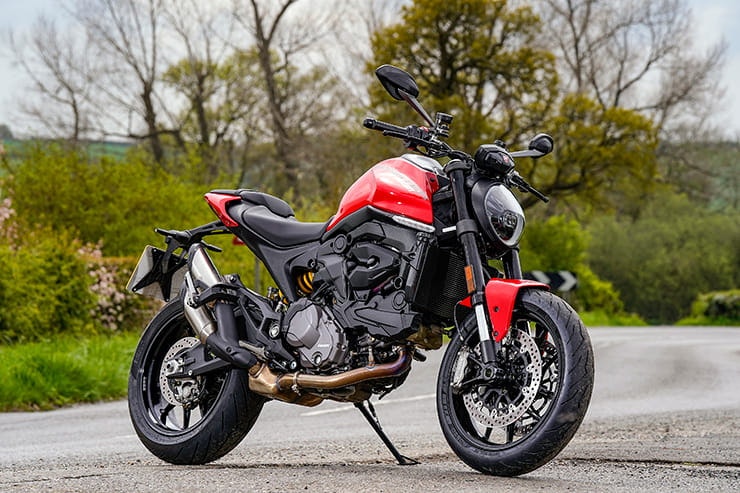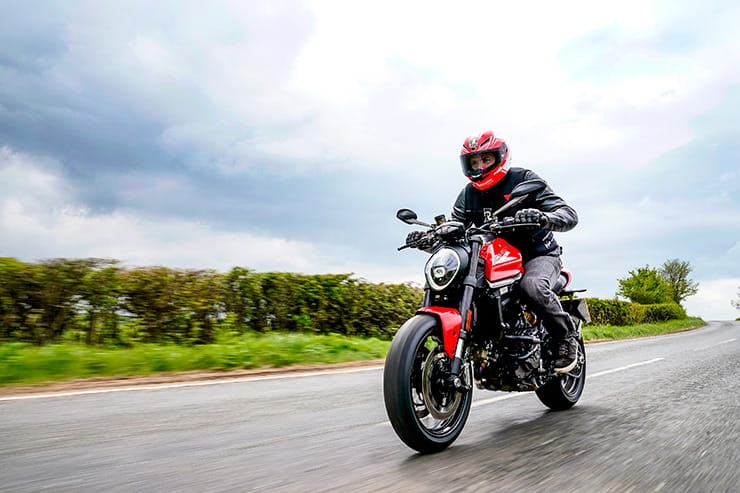Ducati Monster (2021) - Review
By Michael Mann
BikeSocial Managing Editor
24.05.2021
Kit Credits
Helmet
AGV Pista GP-RR (with custom paint job from LDC Designs), £999.99 | www.agv.co.uk
Jacket
Dainese Settantadue Chiodo, £128.98 (at the time of writing) | www.dainese.com
Dainese Smart Jacket (airbag), £649.95 | www.dainese.com
Trousers
Dainese Denim Jeans (previous season) | www.dainese.com
Gloves
Dainese Carbon D1, £109.95| www.dainese.com
Boots
Dainese York Air, £145.95 | www.dainese.com
The Ducati Monster is generally regarded as the bike that allowed Ducati to survive a fairly financially sticky period in the 1990s as without it there was a very real possibility the company would have gone bust. Thankfully for the Italian marque, their creditors allowed them to produce the naked café racer inspired by a movie poster.
28 years after the M900 appeared in 1993 over 350,000 Monsters have been sold worldwide, and just like the original, this new Monster had a superbike-derived chassis (back then it was the 888, nowadays it’s the Panigale) and a road-focused engine. This is the Euro5-spec, 937cc L-Twin that can also be found in the Hypermotard, Multistrada 950 and SuperSport.
As far as Monster’s and their numbers go, the 696, 797, 821 and even the 1200 have all been replaced in 2021 by just one Monster. This one. You could argue it should have been called the Monster 950 but why when there aren’t any other Monsters in the range? This also makes it the lowest capacity Ducati in their current range, if you exclude the Scrambler off-shoot brand. You can make this A2 compliant but a 937cc bike costing £10,385 is now the ‘entry level’ Ducati. Seems a little too premium if you ask me.
But let’s focus on this motorcycle. What does it bring to the party? It’s quite the step-change for Ducati, a nod to the future with a hint of history. We spent a few days with the standard model then invited a photographer and videographer along to capture the action.
Nimble for a nigh-on litre bike
Easy-to-ride, refreshingly untechnical
Long revs with a wide mid-range
Foot peg position is unnecessarily high
Needs a belly fairing as standard
Over the £10k marker
Come for a ride on the 2021 Ducati Monster
BikeSocial’s Michael Mann offers an in-depth look around the new Ducati Monster
Above: 820mm seat height and a narrow waist (the bike not me)
Ducati Monster (2021) Price
How much is the 2021 Ducati Monster? £10,385
Just a few pounds over that psychological £10k figure may be a ploy to underline its premiumness. Mind you, add in the registration and tax and the price boosts up to £10,736, and then if you want the darker of the two available colour schemes than it’s just £74 shy of £11k.
The Monster + model comes with a pillion seat cover and a small screen around the TFT display. It’s just £250 more and is available in the same three colours as the standard version: Ducati Red, Aviator Grey (with red wheels) or Dark Stealth with the latter two having a £200 premium.
And the below PCP example shows the bike at less than £4 a day, so cut your daily mocha chocca latte out and you’re well on the way to having a Monster in your garage:
Power and Torque
In a category full of sprightly, lightweight nakeds from Japan and Europe alike, Ducati’s L-shaped twin provides a claimed peak power output at the crank of 110bhp (82kW) @ 9250rpm while peak torque is measured as 69ft-lbs (93Nm) @ 6500rpm putting firmly in the middle.
But that doesn’t tell you the full story. There’s enough performance low down to keep you keen; the noise is there, its rattly characteristics and thumpy, lumpy pull reminds you of its ancestry but wind it up to where you’d expect to be changing gear, based on aural influence alone it’d be around 6,500rpm, and you’d be excused in thinking ‘yep, this bike’s punchy enough’. Hold on though, because there’s the Monster’s split personality - keep the throttle open and the revs begin to climb even faster. The noise gets better and the sensory attack continues way up to nine grand. You might have flown by the peak torque figure but peak power is up here.
Engine, Gearbox and Exhaust
The 937cc engine is 2.4kg lighter than the 821cc version. The frame – which only attaches the steering head to the engine, using the motor itself as the main rear structure – is 4.5kg lighter than before, weighing a mere 3kg. So the elements for more thrills with a lighter and more powerful machine are plain to see. But this is no MT-09, it won’t have you searching for your eyeballs after a 0-60mph effort, it’s like comparing sirloin to a Big Mac – both taste fab but one’s a little more refined.
I’m not doing the Monster a diss-service, the MT-09 is a wild child and the new Ducati is still full-blooded enough to make your fingers tingle. Away from those lower revs, it spins smoothly and combined with a fantastic up and down quickshifter that is quick, snappy and doesn’t need much pressure nor a long throw to snick the next gear, the duo work in harmony without jolt. We’ll come onto the electronics and rider aids that can be manually adjusted as well as the pre-set modes, but the fast-revving twin and it’s booming grunt fires out of the 2nd and 3rd gear corners with real reward. The riding position accentuates the sporty nature of the 110bhp motor and once you’ve found the optimum traction-related settings, you can abuse that throttle. On the flip side, there’s still an air of natural assurance about the Monster’s power application – it’s still got that suave feel with a hint of brute.
It’s plain to see as well. Naked as the day it was born with little cover, though take one look at the social media comments and I’m not alone in wanting a finishing touch to the lower front of the engine because the ground clearance is huge. I could almost crawl through the gap between the front wheel and engine. Perhaps the designers don’t know about Britain’s salty and grimy winter roads because that engine will get coated, or worse still if the front wheel flicks up all sorts of stones. Thankfully there’s an optional lower/belly fairing available at £173. Shame it’s not included but at least you can negotiate with your dealer.
An over-and-under mid-mounted twin pipe layout uniquely marks the new Monster’s appearance and while emission regulations have had us baulking at many exhausts in recent years, I’m a fan of the Ducati variant, except when looking from the rear and those tiny, pea-shooter baffles are reminiscent of a much smaller capacity engine.
Ducati Monster (2021) Comfort and Economy
I’d understand the new, sportier riding position a little more if the bike had 150bhp but this version doesn’t portray many athletic tendencies on first glimpse. In fact, on my first glimpse of the Monster in real life and not on screen was immediately having jumped off my long-term Multistrada V4, and by comparison the Monster is tiny. Sounds obvious but it’s really small and almost difficult to comprehend that it houses a 937cc engine. It looks much more middleweight than that. From behind you can barely believe how narrow it is too but that doesn’t mean it behaves skittishly on the road. An 820mm seat height is very easy to access because of how little you need to spread your legs and how thin the waist of the bike is. The seat height can be adjusted with a low seat option which takes the height to 800mm, and then further still with a suspension lowering kit that’ll take it to 775mm (£216 accessory). Ducati claims the seat to peg distance is higher and the riding position is more upright but from the miles I covered I felt the opposite, though not necessarily too uncomfortable. I felt naturally tipped forward with my nose virtually over the TFT display with weight more over the front, that helped with grip when turning – something this bike is very good at, I hasten to add – though it still allowed me to shuffle backwards for the very unprotected motorway miles if needed.
The peg position allows for plenty of ground clearance, too much perhaps. There won’t be many Monsters used on track days but that’ll be the only place you’ll need that level of clearance. By dropping the pegs by at least 10mm would allow for more leg comfort on the longer journeys too. I stand 6ft (183cm) tall with a long legs and it took a little getting used to the position.
The fuel tank is tiny too, there’s enough space to hold an alleged 14-litres but its dimensions fit with the rest of the bike, keeping the bike light enough for some sporty handling while still returning almost 50mpg. That would result in a theoretical tank range to empty of 150-miles. Not massive but the compromise of keeping the weight down is worth it.
Handling, Suspension and Weight
We’ve talked about the price and the motor but there’s two other stand-out points: weight and frame. At 188kg ready-to-ride, it’s 18kg lighter than the out-going 821. If a football team scores seven or more goals they tend to have the word in brackets next to the number to reiterate the hight score, well this deserves an (eighteen) next to its weight loss, that’s nearly 40 lbs.
At the back, Ducati has used glass-fibre reinforced polymer (GFRP) instead of metal for the seat subframe to save another 1.9kg, while the wheels are 1.7kg lighter and the swingarm drops 1.6kg. If there was a Slimmer of the Year award for bikes, it would go to the Monster. It’s instantly noticeable too even at standstill, it’s so light to manoeuvre with a seemingly better lock-to-lock range for tighter u-turns than the 821 and 1200.
Secondly, and it’s not gone amiss on the social media platforms since the model was unveiled back in December 2020, but the trellis frame which so many believe define a Monster has gone. In its place an aluminium frame similar to that of the Panigale sports bikes. Purists might baulk but this is a new dawn for the Monster and trellis or not, this is the modern day version that stands alone. Is it too similar to Japanese equivalents? From the side and without a Ducati badge, would you recognise it?
While it’s post-lockdown pound-shedding has worked wonders for the road handling, it still remains perfectly poised once committed to a line even without a steering damper. The chassis is well put together, compact with its width and even its shorter wheelbase. Even the steering head angle is up by 7° to encourage greater agility, telling by its keenness for corner speed, as the non-adjustable (and apparently fairly budget) suspension offers decent balance, minimal dive or juddery rebound. The front forks and pre-load adjustable monoshock are accompanied for grip with a set of excellent quality Pirelli Diablo Rosso III tyres which, during a lot of my test ride, were pushed in the dry and wet, holding up admirably even in monsoon-like conditions on one particular 10-mile stretch. They suit the bikes’ all-purpose persona well and look good to boot.
Ducati Monster (2021) Brakes
Radially-mounted Brembo M4.32 Monobloc 4-piston callipers with twin 320mm semi-floating discs are plenty for this nifty young Monster. 110bhp at 188kg (plus rider) on a strongly suspended naked isn’t a combination that requires more premium and therefore more expensive stopping componentry. The typically long and ergonomically-friendly levers are distance adjustable and offer a strong and nicely progressive feel. Engine braking can be manually adjusted in the electronics suite too.
The rear ABS can be easily disabled for those with hooliganistic tendencies enchanted with leaving black lines on the road, while cornering ABS is included in the fine set of rider aids. It too is adjustable.
Rider aids/Accessories
In spite of the Monster’s minimalism, its creators have tucked away plenty of gadgets to keep you safer but also to offer a degree of customisation for each ride or rider, all controllable via the 4.3” colour TFT display. It’s easy -to-read with bold fonts, though I’d argue it could be a little bigger considering how much information it’s offering. If it could be tilt-adjustable allowing for shorter or taller riders that would be ace too, though glare was never a problem.
Ride-by-wire technology allow three customisable riding modes that have their own pre-sets; Sport, Touring and Urban offer unique settings for engine power, throttle responsiveness, traction control intervention, ABS, rear wheel lift and wheelie control. Urban modes cuts power down to 74bhp. I tested ABS in mode 1 which offered the least intervention (it’s also the ‘front only’ mode) and the same Traction Control mode yet despite my eager throttle hand in slightly damp conditions, I couldn’t disturb the bike’s stability and grip enough to warrant clenching.
A minor upgrade but nonetheless so aesthetically pleasing and smart too, is the car-esque scrolling front indicators integrated into the bodywork between frame and tank which accentuate the archetypal round-ish Monster headlight.
Heated grips aren’t fitted as standard but are available as an official accessory at £263, a racing silencer set is £1836, while the non-racing version is £1250 – both by Termignoni. Carbon mudguards, windscreen, a headlight fairing, alternative mirrors and a shorter licence plate holder are also among the official extras. But it’s that lower belly fairing that’d be my first add-on.
Rivals
Sitting in the so-called ‘middleweight naked’ category, mainly because each of these examples have a larger capacity naked sibling, we could have included the Kawasaki Z900, Suzuki GSX-S1000 (or even the 750) or, at a push, Honda’s CB1000R among the options. In this table, we’ve got three Europeans, two of whom are triples, and if these were your final four to pitch against the Ducati, then I’d suggest grabbing a checklist and seeing how they compare for rider aids, mpg figures, service intervals and locality of your local dealer, etc:
Ducati Monster (2021) Verdict
Unless you’re wooed by the Scrambler range then the, dare I say it, ‘entry level’ Monster is now a thing of the past. OK, so it’s not like they’ve all just disappeared but a 937cc, £10k naked bike is currently Ducati’s smallest bike. I understand the premium nature of the brand but it’s a bold move to cut the 821. That said, there is an A2 version available.
Despite those ambivalent Monster looks and how jacked-up it appears, there’s some excellent build quality on display and the modern-day Ducati classy feel certainly apparent... emphasis on ‘some’ because in other places it’s most un-Ducati like with exposed wires, grim-looking lambda sensors and the split front brake line.
The motor is strong and with its split personality is good for a blasé B-road bimble or a more boisterous blast depending on how many revs you feel like using. Superb light handling is suitable for any type of ride – even city commuting, it’s a doddle to ride and at sub-£120 a month it’s a rewarding package… so long as the lack of lower belly fairing and its un-Monster like appearance don’t grate on you too much.
Ducati Monster (2021) Technical Specification
To learn more about what the spec sheet means, click here for our glossary
Photos by Tim Keeton / Impact Images
Video by Dom Read-Jones / Motion Films
What is MCIA Secured?
MCIA Secured gives bike buyers the chance to see just how much work a manufacturer has put into making their new investment as resistant to theft as possible.
As we all know, the more security you use, the less chance there is of your bike being stolen. In fact, based on research by Bennetts, using a disc lock makes your machine three times less likely to be stolen, while heavy duty kit can make it less likely to be stolen than a car. For reviews of the best security products, click here.
MCIA Secured gives motorcycles a rating out of five stars, based on the following being fitted to a new bike as standard:
A steering lock that meets the UNECE 62 standard
An ignition immobiliser system
A vehicle marking system
An alarm system
A vehicle tracking system with subscription
The higher the star rating, the better the security, so always ask your dealer what rating your bike has, and compare it to other machines on your shortlist.


